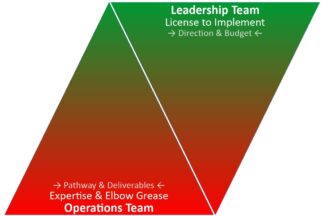‘The conversation is always about cost, not about impact!’ And: ‘Employees just don’t get moving!’
Do these statements remind you of your company’s challenges? Your not alone!
Leadership and Operations Teams have complementary sustainability implementation accountabilities and responsibilities. But instead of leveraging that fact, more often than not the blame game is played.
What to do about it?
Implement Fair Process Leadership governance processes - and train all teams through Serious Games.
This time around I want to make it explicit: If a company is not performing in sustainability terms, it as good as always down to senior leadership. Both, executive leadership – CEO, COO, CFO, CMO,
CSO etc. - as well as non-executive leadership at board level.
For one, arguably simplistic, reason: sustainability deliverables are oversteered by
‘higher priority’ KPIs. And what does mean? Fundamentally, it is down to decisions where the ball stops at the top leadership level.
Do you recognise these scenarios?
"The good thing about Science is that it’s true, whether or not you believe in it." This short quote by astrophysist Neil deGrasse Tyson is fundamental to making true progress specifically in the current times in the sustainability area.
Science does not mean 'claim what you want as long as you have some data to go with it'.
Instead it means: An approach whereby hard data and insights, together with the methodology how you got there, are transparently and openly provided. To be scuritinzed and - important! - improved upon.
A call to give the Scientific Discourse waaaay more airtime in business.
An NGO comes after you – for the right or the wrong reasons.
A journalist publishes an article. The content: inconvenient truths, or equally inconvenient fake news.
Or simpler: The staff churn in your company is way above average. And no one seems to know why.
The meetings, the clashes, the disagreement, the blaiming that comes with it. Yes, been there, done that.
Thankfully, there were times I was not a party in the conflict. Instead I was assigned the (ungrateful?) task of figuring out how to resolve it, build bridges, and ‘get stuff done’. Not just once, but a few times.
What initially was of me ‘winging it’, over time – with trial and error – turned into something more structured. Still not perfect – it never will be, there is always room for improvement – but a flight-by-instrument rather than a blind adventure.
This post is my first try at illustrating, verbalising, this process.The steps I use, and what their intention is.
With the hope of it being as useful to others as it is and was to me.
Consistency is one of those traits that is coveted by business journals and business leadership as possibly the most important ingredient in leaders. For a simple reason: Consistency — whether good or bad, positive or negative — provides the business, its employees, and stakeholders with a known quantity.
But what is often forgotten: A leader is never, ever made over night. It is a life long process. And just like a relationship, the accumulation and significance of small little things that are done over and over again is more often than not underestimated.
Fairy tales are typically something for kids. Particularly young kids. Over the centuries they have been used to convey fundamental social mores, warnings from danger, and to inoculate a shared understanding of what ‘good’ and ‘bad’ looks like. These characteristics though make fairy tales an ideal, if very uncommon, vehicle to convey information and learnings also in management literature. This book hence is a rare find.
Decisions in companies, brands, and businesses are never based either on a single argument, or the consequence of a single person’s ‘way’. Rather, companies have, to an extent, their own personality.
Key Question: a decision taken by this organisation – is it largely independent from, or a necessary consequence of, the decision(s) that the individuals within the organisation have taken?
The world of sustainability in fashion has changed fundamentally in the last few years. In this article we look at qualities that leaders such as Patagonia's Yves Chouinard have, that make them the movers and shakers of the sustainability agenda in the industry at large.








